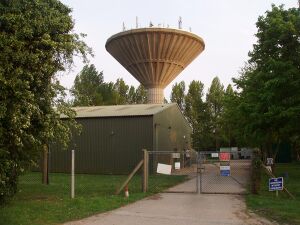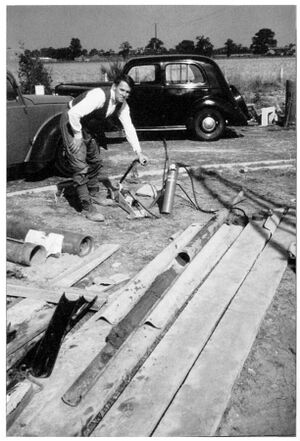Earth:Ludham Borehole

The Ludham Borehole was a geological research borehole drilled in 1959 near Ludham, Norfolk, UK. A continuous core sample of late Pliocene and early Pleistocene sediments of the Crag Group was recovered. Analysis allowed biostratigraphic zonal schemes for fossil pollen, foraminifera, mollusca and dinoflagellates to be constructed for horizons of the Red Crag and Norwich Crag Formations, and for these formations to be thus correlated with strata of equivalent age in the North Sea basin and north-west Europe.
History of investigation

In 1950 a pilot borehole was put down for exploratory water supply purposes at the Smallburgh Rural District Council waterworks at Wateringpiece Lane, Catfield, near Ludham. Investigation of sediment samples was carried out for fossil foraminiferan content by Brian Funnell and for pollen by Colin Forbes. In 1959 the Royal Society of London financed a research borehole located 80 m to the east. It penetrated Pliocene and Pleistocene deposits of the Crag Group to a depth of 50 m, and found them resting on deposits of the Eocene London Clay Formation.[1] Sediment samples were analysed for their fossil pollen, foraminiferan and molluscan content by Richard West, Brian Funnell and Peter Norton,[2] and later by Martin Head and others for dinoflagellates[3] This research has confirmed the value of the Ludham Borehole for understanding the Pliocene and Pleistocene geology of East Anglia, and for correlation with strata of equivalent age in the North Sea basin and north-west Europe. The findings have since been supplemented by the results from the Ormesby Borehole.[4] The Ludham Borehole is the type site for the Ludhamian Stage[5] which has been correlated with part of the Praetiglian Stage on the continent, and tentatively correlated with the transition of Marine Isotope Stages 97 to 96.[6]
Stratigraphy
The borehole log has been given by West (1962).[7] It was considered that the sedimentary sequence between – 7.6 and –49.7 m depth (grey sands, silts and clays) clearly belonged to the Crag Group. The sequence above this (brown sands with yellow clay seams and ferruginous material) was considered to resemble the uppermost division of Norwich Crag as described by Woodward (1881),[8]:31 attributed to the Bure Valley Beds (now referred to the Wroxham Crag Formation. The geology at this location has been mapped by the British Geological Survey as glacial deposits of the Corton Formation overlying Crag Group (undifferentiated).[9]
Fauna and flora
Molluscs
Work by Norton (1967) investigated the molluscan fossils from the Ludham Borehole. A sequence of six biostratigraphic assemblage zones was identified, and the results correlated with palaeontological research at this and other sites.[10] It was noted by Norton (1977) that the molluscan fauna gave no indication of the clearly cyclical temperature changes evident from pollen and foraminiferal fossils in the Ludham sequence, and hence it was unreliable for palaeoclimatic interpretation.[11]:50
Plants
A sequence of pollen assemblage zones was identified by West (1962), which permitted the designation of five biostratigraphic stages. 1. (the oldest) Ludhamian, with temperate mixed coniferous/deciduous forest including Tsuga and Pterocarya; 2. Thurnian, a glacial stage with an oceanic heath type of vegetation; 3. Antian, with temperate mixed coniferous/deciduous forest including Tsuga and Pterocarya; 4. Baventian, a glacial stage more severe than the Thurnian, with the return of oceanic heaths; 5. An unnamed stage with temperate mixed coniferous/deciduous forest lacking Pterocarya and with only a few traces of Tsuga. These stages were provisionally correlated with Early Pleistocene stages in the Netherlands: the Ludhamian with the Tiglian, the Thurnian with Eburonian, the Antian with Waalian, and the Baventian with Menapian.[7] The unnamed stage was later tentatively correlated with the Pastonian.[12]:117 Further work was later conducted on Ludham pollen samples, yielding evidence for input by British rivers into the Crag sedimentary sequence in the southern North Sea basin.[13]
Dinoflagellates
Dinoflagellate assemblages were analysed by Wall & Dale (1968), and were found to correspond with five facies associations in the sequence identified by West (1962).[14] More detailed work was later conducted by Head (1996), permitting the identification of over 29 species.[3]
Foraminifers
A sequence of seven foraminiferal assemblage zones were identified by Funnell (1961) on the basis of research into the Ludham Pilot Boring. Those from the lower part of the sequence were correlated with the Red Crag Formation and from the upper part with the Norwich Crag Formation. The uppermost zone (7) had an arctic-type fauna correlated with the Weybourne Crag[1] (now referred to the Wroxham Crag Formation).
See also
- Geologic time scale
- Geology of England
- Geology of the North Sea
- Norwich Crag Formation
- Palaeontology
- Pleistocene
- Pliocene
- Red Crag Formation
References
- ↑ 1.0 1.1 Funnell, BM (1961). The Palaeogene and early Pleistocene of Norfolk. Transactions of the Norfolk and Norwich Naturalists’ Society, vol.19, pt.6.
- ↑ West, RG (2000). A recollection from 50 years of Quaternary research in East Anglia. In: Dixon, RG (ed). The Geological Society of Norfolk. 50th Anniversary Volume. Geological Society of Norfolk, December 2000.
- ↑ 3.0 3.1 Head, MJ (1996). Late Cenozoic dinoflagellates from the Royal Society borehole at Ludham, Norfolk, eastern England. Journal of Paleontology, vol.70, no.4, pp.543-570.
- ↑ Arthurton, RS, Booth, SJ, Morigi, AN, Abbott, MAW & Wood, CJ (1994). Geology of the country around Great Yarmouth. Memoir for 1:50,000 Geological Sheet 162. British Geological Survey, HMSO, London.
- ↑ Funnell, BM & West, RG (1977). Preglacial Pleistocene deposits of East Anglia. In: Shotton, FW (ed). British Quaternary Studies: recent advances. Oxford University Press, 1977. ISBN:0 19 854414 6.:260
- ↑ Meijer, T, Cleveringa, P, Munsterman, DK & Verreussel, CH (2006). The Early Pleistocene Praetiglian and Ludhamian pollen stages in the North Sea Basin and their relationship to the marine isotope record. Journal of Quaternary Science vol.21.3.
- ↑ 7.0 7.1 West, RG (1962). Vegetational history of the Early Pleistocene of the Royal Society Borehole at Ludham, Norfolk. Proceedings of the Royal Society of London, Series B, vol.155, pp.437-453.
- ↑ Woodward, HB (1881). The Geology of the Country around Norwich. Memoirs of the Geological Survey of the United Kingdom.
- ↑ British Geological Survey (1999). Mundesley and North Walsham. England and Wales Sheets 132 and 148. Solid and Drift Geology. 1:50,000. British Geological Survey, Keyworth, Nottingham.
- ↑ Norton, PEP (1967). Marine Molluscan Assemblages in the Early Pleistocene of Sidestrand, Bramerton and the Royal Society Borehole at Ludham, Norfolk. Philosophic Transactions of the Royal Society of London, Series B, vol.253, no.784.
- ↑ Norton, PEP (1977). Marine Mollusca in the East Anglian pre-glacial Pleistocene. In: Shotton, FW (ed). British Quaternary Studies - Recent Advances. Clarendon Press, Oxford, 1977.
- ↑ West, RG (1980). The pre-glacial Pleistocene of the Norfolk and Suffolk Coasts. Cambridge University Press. ISBN:0521219620.
- ↑ Riding, JB, Moorlock, SP, Jeffrey, DH & Hamblin, RJO (1997). Reworked and indigenous palynomorphs from the Norwich Crag Formation (Pleistocene) of eastern Suffolk: implications for provenance, palaeogeography and climate. Proceedings of the Geologists’ Association, vol. 108, pt.1.
- ↑ Wall, D & Dale, B (1968). Early Pleistocene dinoflagellates from the Royal Society borehole at Ludham Norfolk. New Phytologist, vol.67, pp.315-326.
Further reading
- Arthurton, RS, Booth, SJ, Morigi, AN, Abbott, MAW & Wood, CJ (1994). Geology of the country around Great Yarmouth. Memoir for 1:50,000 Geological Sheets 162. British Geological Survey, HMSO, London. ISBN:011 884491 1.
- Dixon, RG (ed) (2012). A Celebration of Suffolk Geology. GeoSuffolk 10th Anniversary Volume. GeoSuffolk, Ipswich. ISBN:0 9508154 7 0.
- Moorlock, BSP, Hamblin, RJO, Booth, SJ & Woods, MA (2002). Geology of the Mundesley and North Walsham District. A brief explanation of the geological map Sheet 132 Mundesley and Sheet 148 North Walsham. British Geological Survey, Keyworth. ISBN:0 85 272438 1.
External links
- BGS Stratigraphic Lexicon: Norwich Crag Formation [1]
- BGS Stratigraphic Lexicon: Red Crag Formation [2]
- Geological Society of Norfolk [3]
- Norfolk Geodiversity Partnership [4]
- Quaternary Research Association [5]
 |

